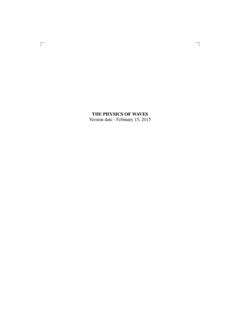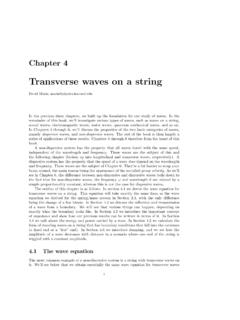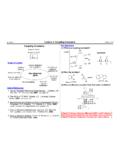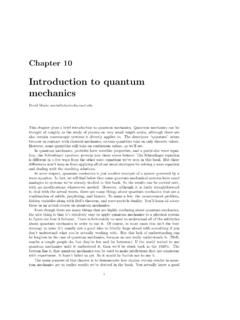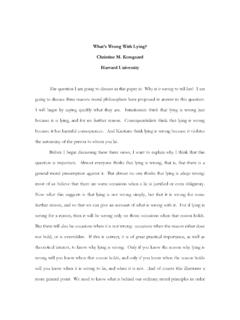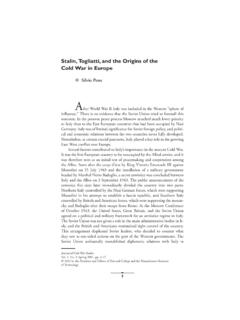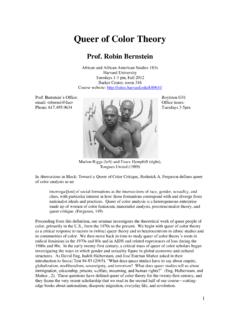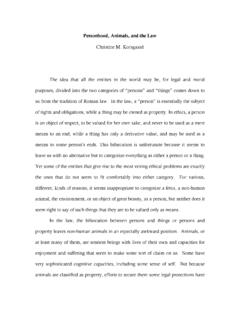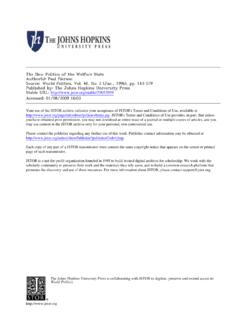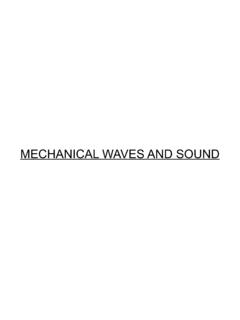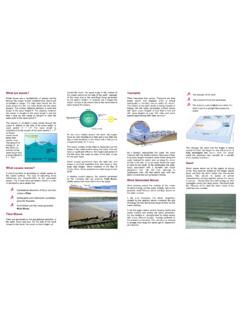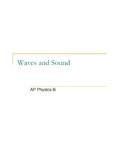Transcription of Electromagnetic waves - Harvard University
1 Chapter 8 Electromagnetic wavesDavid Morin, waves we ve dealt with so far in this book have been fairly easy to visualize. Wavesinvolving springs/masses, strings, and air molecules are things we can apply our intuition we ll now switch gears and talk about Electromagnetic waves . These are harder to geta handle on, for a number of reasons. First, the things that are oscillating are electric andmagnetic fields, which are much harder to see (which is an ironic statement, considering thatwe see with light, which is an Electromagnetic wave). Second, the fields can have componentsin various directions, and there can be relative phases between these components (this willbe important when we discuss polarization).
2 And third, unlike all the other waves we vedealt with, Electromagnetic waves don t need a medium to propagate in. They work justfine in vacuum. In the late 1800 s, it was generally assumed that Electromagnetic wavesrequired a medium, and this hypothesized medium was called the ether. However, no onewas ever able to observe the ether. And for good reason, because it doesn t chapter is a bit long. The outline is as follows. In Section we talk about waves inan extended LC circuit, which is basically what a coaxial cable is. We find that the systemsupports waves , and that these waves travel at the speed of light.
3 This section serves asmotivation for the fact that light is an Electromagnetic wave. In Section we show howthe wave equation for Electromagnetic waves follows from Maxwell s equations. Maxwell sequations govern all of electricity and magnetism, so it is no surprise that they yield thewave equation. In Section we see how Maxwell s equations constrain the form of thewaves. There is more information contained in Maxwell s equations than there is in thewave equation. In Section we talk about the energy contained in an electromagneticwave, and in particular the energy flow which is described by thePoynting vetor.
4 In we talk about the momentum of an Electromagnetic wave. We saw in Section thatthe waves we ve discussed so far carry energy but not momentum. Electromagnetic wavescarry Section we discuss polarization, which deals with the relative phasesof the different components of the electric (and magnetic) field. In Section we showhow an Electromagnetic wave can be produced by an oscillating (and hence accelerating)charge. Finally, in Section we discuss the reflection and transmission that occurs whenan Electromagnetic wave encounters the boundary between two different regions, such as air1 Technically, all waves carry momentum, but this momentum is suppressed by a factor ofv/c, wherevisthe speed of the wave andcis the speed of light.
5 This follows from the relativity fact that energy is equivalentto mass. So a flow of energy implies a flow of mass, which in turn implies nonzero momentum. However,the factor ofv/ccauses the momentum to be negligible unless we re dealing with relativistic 8. Electromagnetic WAVESand glass. We deal with both normal and non-normal angles of incidence. The latter is abit more involved due to the effects of Cable wavesBefore getting into Maxwell s equations and the wave equation for light, let s do a warmupexample and study the Electromagnetic waves that propagate down a coaxial cable.
6 Thisexample should help convince you that light is in fact an Electromagnetic get a handle on the coaxial cable, let s first look at the idealized circuit shown inFig. 1. All the inductors areL, and all the capacitors areC. There are no resistors in thecircuit. With the charges, currents, and voltages labeled as shown, we have three facts:1. The charge on a capacitor isQ=CV= qn= The voltage across an inductor isV=L(dI/dt) = Vn 1 Vn=L(dIn/dt).3. Conservation of charge givesIn In+1= +1 VnVn-1Vn-2qn-qnqn+1-qn+1qn-1-qn-1qn-2-qn -2In-1In+1(ground)V=0all inductors = Lall capacitors = CFigure 1 Our goal is to produce an equation, which will end up being a wave equation, for one ofthe three variables,q,I, andV(the wave equations for all of them will turn out to be thesame).
7 Let s eliminateqandI, in favor ofV. We could manipulate the above equations intheir present form in terms of discrete quantities, and then take the continuum limit (seeProblem [to be added]). But it is much simpler to first take the continuum limit and thendo the manipulation. If we let the grid size in Fig. 1 be x, then by using the definition ofthe derivative, the above three facts becomeq=CV, x V x=L I t, x I x= q t.(1)Substitutingq=CVfrom the first equation into the third, and defining the inductance andcapacitance per unit length asL0 L/ xandC0 C/ x, the last two equations become V x=L0 I t,and I x=C0 V t.
8 (2)If we take / xof the first of these equations and / tof the second, and then equate theresults for 2I/ x t, we obtain 1L0 2V x2= C0 2V t2= 2V(x, t) t2=1L0C0 2V(x, t) x2(3) THE WAVE EQUATION3 This is the desired wave equation, and it happens to be dispersionless. We can quickly readoff the speed of the waves , which isv=1 L0C0.(4)If we were to subdivide the circuit in Fig. 1 into smaller and smaller cells,LandCwoulddepend on x(and would go to zero as x 0), so it makes sense to work with thequantitiesL0andC0. This is especially true in the case of the actual cable we ll discussbelow, for which the choice of xis the meaningful quantities thatare determined by the nature of the that since the first fact above says thatq V, the exact same wave equation holdsforq.
9 Furthermore, if we had eliminatedVinstead ofIin Eq. (2) by taking / tof thefirst equation and / xof the second, we would have obtained the same wave equation forI, too. SoV,q, andIall satisfy the same wave s now look at an actual coaxial cable. Consider a conducting wire inside a conductingcylinder, with vacuum in the region between them, as shown in Assume that the wireFigure 2is somehow constrained to be in the middle of the cylinder. (In reality, the inbetween regionis filled with an insulator which keeps the wire in place, but let s keep things simple herewith a vacuum.)
10 The cable has an inductanceL0per unit length, in the same way that twoparallel wires have a mutual inductance per unit length. (The cylinder can be consideredto be made up of a large number wires parallel to its axis.) It also has a capacitanceC0per unit length, because a charge difference between the wire and the cylinder will create avoltage can be shown that (see Problem [to be added], although it s perfectly fine to justaccept this)L0= 02 ln(r2/r1) andC0=2 0ln(r2/r1),(5)wherer2is the radius of the cylinder, andr1is the radius of the wire. The two physicalconstants in these equations are thepermeability of free space, 0, and thepermittivity offree space, 0.
